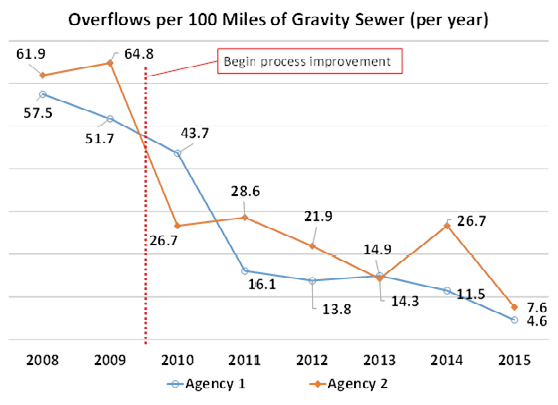Attacking Sanitary Sewer Overflows

By Billy Wright, senior consultant, LA Consulting
California municipalities write the book on solving sanitary sewer overflows by sharing best practices and technology tips.
A Tale Of Two Cities
Two California cities dramatically reduced the occurrence of sanitary sewer overflows (SSOs) through enhanced technology and business process improvement. The effort included evaluating operations to establish a performance baseline, implementing multiple best business practices/strategies, and using technology to manage the data.
A host of best business practices was used that ranged from streamlining workflows to utilizing advanced technology. For example, a complete computerized maintenance management system (CMMS) with geographical information system (GIS) connectivity and closed circuit television (CCTV) data was used to enhance routine schedules, track work, and improve operations.
This transformation led to improvements in the efficiency and effectiveness of operations, with increased quality as a direct result of routine cleaning, improved work reporting practices, application of good business tools, and integration and automation of work processes. These efforts and related implementations produced the desired effects of SSO reductions in both agencies.
Behind SSO
SSO is a condition in which untreated sewage is discharged into the environment prior to reaching sewage treatment facilities. It can be the result of a wastewater sewer system either having an overflow, spill, release, discharge, or diversion of untreated or partially treated wastewater. Some of the factors that can create these issues include infiltration or inflow of excessive stormwater into sewer lines during heavy rainfall, rupture or blockage of sewerage lines, malfunction of pumping station lifts or electrical power failure, and human operator error at treatment plant facilities.
The U.S. EPA estimates the magnitude of the problem to be about 40,000 SSO events occurring in the U.S. each year1. The volume of untreated sewage discharged to the environment is less than 0.01 percent of all treated sewage in the U.S.; the total volume amounts to several billion gallons per annum and accounts for thousands of cases of gastrointestinal illness each year2.
Numerous municipalities and special districts that manage wastewater systems must face the seemingly insurmountable challenge of adhering to court-mandated consent decree orders or agreements made by environmental groups and regulatory agencies against responsible entities who manage wastewater systems. These efforts include operational performance, environmental stewardship, and regulatory reporting requirements, or else they incur hefty penalties for this pollution and non-compliance. Shrinking budgets may be unavoidable, and other methods must be used in lieu of increased staffing in order to optimize resources and accomplish organizational goals while still meeting all regulatory requirements. The risk of not meeting these requirements not only endangers the public and the environment but also results in large fiscal impacts as a consequence of fines or fees.
Improved By Necessity
The sewer networks for each city range in size from 87 to 105 miles of gravity sewer and have approximately 13,000 and 11,000 service connections respectively. Each agency operates and maintains six lift stations and produces an average of 3.5 million to 4 million gallons of wastewater per day. Evaluation of sewer network performance is often summarized by a single value, which is calculated as the total number of SSO occurrences per 100 miles of gravity sewer. This value is reported to the state water board and used as a benchmark by state regulators, environmental groups, and wastewater agency management.
Prior to the implementation of improved business processes and related management tools, both agencies were consistently experiencing 50 or more SSOs per 100 sewer miles, while the state average is fewer than seven. This resulted in legal actions filed by various environmental groups and two separate courtmandated consent decree orders that established specific limits for SSO events, requirements for performance reporting, and substantial increases in maintenance responsibility and system monitoring. Failure to adhere to this sudden increase in workload would result in overwhelming fines and penalties for small cities with already limited financial resources.
Figure 1

Approach
Each agency implemented a complete computerized maintenance management system as part of the improvement process. Business processes were established that provided management data and tools to best direct the available resources. These included establishing a performance-based work plan and budget that related accounted resources with actual work accomplishment. Performance metrics were also identified that established benchmarks for productivity and unit costs that could be monitored through the use of standard outputs and reports.
After determining the annual performance plan and budget for each maintenance activity, a monthly work calendar was developed to identify potential peaks in the workload and identify any need for additional contractor support. Short-term scheduling procedures aided by GIS outputs were established and utilized a combination of the performance plan, work calendar, and consent decree requirements as inputs when assigning crews to specific efforts.
The CMMS was configured in each agency to support the established business processes and monitor critical parameters defined by management. Output reports were also developed that compared the planned values to actual work reporting in order to periodically monitor operational performance and affirm adherence to management goals.
Results
Each agency now has complete and transparent awareness of wastewater conditions and employee work effort, and has specific information available for all users of the system within two weeks of work completion. They have developed activity-based work plans that outline the annual work load distribution and unit cost estimates for all defined tasks. Guidelines include resource requirements, work method, and quality of results that relate all work to cost. These changes have resulted in a data-driven, focused approach based on business practices with direct accountability established.
With these tools in place, each agency has experienced an approximately 90 percent decrease in SSO events per 100 sewer miles since implementation. The annual value for each agency is shown in Figure 1 starting at 61.9 SSOs per 100 miles for one and 57.5 for the other and ending with 7.6 and 4.6 SSO per 100 miles. Both agencies have shown consistent and dramatic improvement in performance with no additional resources assigned to wastewater collection maintenance groups in either case.
These two agencies demonstrate that such an SSO problem can be addressed by establishing performance-based planning linked to assets and their conditions. This, along with realtime monitoring of work against specific goals and applying best management practices by dedicated employees, can help improve the environment with measurable results.
References
1. U.S. Environmental Protection Agency (EPA). Washington, D.C. “Sanitary Sewer Overflows and Peak Flows”, Updated February 2012.
2. EPA. “Report to Congress: Impacts and Control of CSOs and SSOs”, Executive Summary. August 2004. Document No. EPA-833-R-04-001.
About The Author
 Billy Wright (bwright@laconsulting.com) is a senior consultant with LA Consulting. The company, established in 1993, provides a wide variety of planning, systems, and technology services applied to public agencies and municipalities with an emphasis on systems implementation and technical support for public works operations and maintenance. The firm’s corporate headquarters is in Manhattan Beach, CA, about 20 miles west of Los Angeles.
Billy Wright (bwright@laconsulting.com) is a senior consultant with LA Consulting. The company, established in 1993, provides a wide variety of planning, systems, and technology services applied to public agencies and municipalities with an emphasis on systems implementation and technical support for public works operations and maintenance. The firm’s corporate headquarters is in Manhattan Beach, CA, about 20 miles west of Los Angeles.
